The Pathway To Establishing HIV Latency Is Critical to How Latency Is Maintained and Reversed
- PMID: 29643247
- PMCID: PMC6002734
- DOI: 10.1128/JVI.02225-17
The Pathway To Establishing HIV Latency Is Critical to How Latency Is Maintained and Reversed
Abstract
HIV infection requires lifelong antiretroviral therapy because of the persistence of latently infected CD4+ T cells. The induction of virus expression from latently infected cells occurs following T cell receptor (TCR) activation, but not all latently infected cells respond to TCR stimulation. We compared two models of latently infected cells using an enhanced green fluorescent protein (EGFP) reporter virus to infect CCL19-treated resting CD4+ (rCD4+) T cells (preactivation latency) or activated CD4+ T cells that returned to a resting state (postactivation latency). We isolated latently infected cells by sorting for EGFP-negative (EGFP-) cells after infection. These cells were cultured with antivirals and stimulated with anti-CD3/anti-CD28, mitogens, and latency-reversing agents (LRAs) and cocultured with monocytes and anti-CD3. Spontaneous EGFP expression was more frequent in postactivation than in preactivation latency. Stimulation of latently infected cells with monocytes/anti-CD3 resulted in an increase in EGFP expression compared to that for unstimulated controls using the preactivation latency model but led to a reduction in EGFP expression in the postactivation latency model. The reduced EGFP expression was not associated with reductions in the levels of viral DNA or T cell proliferation but depended on direct contact between monocytes and T cells. Monocytes added to the postactivation latency model during the establishment of latency reduced spontaneous virus expression, suggesting that monocyte-T cell interactions at an early time point postinfection can maintain HIV latency. This direct comparison of pre- and postactivation latency suggests that effective strategies needed to reverse latency will depend on how latency is established.IMPORTANCE One strategy being evaluated to eliminate latently infected cells that persist in HIV-infected individuals on antiretroviral therapy (ART) is to activate HIV expression or production with the goal of inducing virus-mediated cytolysis or immune-mediated clearance of infected cells. The gold standard for the activation of latent virus is T cell receptor stimulation with anti-CD3/anti-CD28. However, this stimulus activates only a small proportion of latently infected cells. We show clear differences in the responses of latently infected cells to activating stimuli based on how latent infection is established, an observation that may potentially explain the persistence of noninduced intact proviruses in HIV-infected individuals on ART.
Keywords: T cells; human immunodeficiency virus; latency; monocytes.
Copyright © 2018 American Society for Microbiology.
Figures

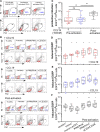
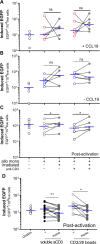
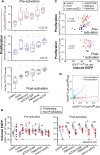

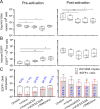

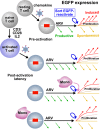
Similar articles
-
Expression and reactivation of HIV in a chemokine induced model of HIV latency in primary resting CD4+ T cells.Retrovirology. 2011 Oct 12;8:80. doi: 10.1186/1742-4690-8-80. Retrovirology. 2011. PMID: 21992606 Free PMC article.
-
In vivo analysis of the effect of panobinostat on cell-associated HIV RNA and DNA levels and latent HIV infection.Retrovirology. 2016 May 21;13(1):36. doi: 10.1186/s12977-016-0268-7. Retrovirology. 2016. PMID: 27206407 Free PMC article.
-
HIV-1 latency and virus production from unintegrated genomes following direct infection of resting CD4 T cells.Retrovirology. 2016 Jan 5;13:1. doi: 10.1186/s12977-015-0234-9. Retrovirology. 2016. PMID: 26728316 Free PMC article.
-
Reservoirs for HIV-1: mechanisms for viral persistence in the presence of antiviral immune responses and antiretroviral therapy.Annu Rev Immunol. 2000;18:665-708. doi: 10.1146/annurev.immunol.18.1.665. Annu Rev Immunol. 2000. PMID: 10837072 Review.
-
Experimental approaches to the study of HIV-1 latency.Nat Rev Microbiol. 2007 Feb;5(2):95-106. doi: 10.1038/nrmicro1580. Nat Rev Microbiol. 2007. PMID: 17224919 Review.
Cited by
-
The multifaceted nature of HIV latency.J Clin Invest. 2020 Jul 1;130(7):3381-3390. doi: 10.1172/JCI136227. J Clin Invest. 2020. PMID: 32609095 Free PMC article. Review.
-
Insights into the HIV-1 Latent Reservoir and Strategies to Cure HIV-1 Infection.Dis Markers. 2022 May 31;2022:6952286. doi: 10.1155/2022/6952286. eCollection 2022. Dis Markers. 2022. PMID: 35664434 Free PMC article. Review.
-
The Proviral Reservoirs of Human Immunodeficiency Virus (HIV) Infection.Pathogens. 2024 Dec 30;14(1):15. doi: 10.3390/pathogens14010015. Pathogens. 2024. PMID: 39860976 Free PMC article. Review.
-
Entry of Polarized Effector Cells into Quiescence Forces HIV Latency.mBio. 2019 Mar 26;10(2):e00337-19. doi: 10.1128/mBio.00337-19. mBio. 2019. PMID: 30914509 Free PMC article.
-
Yoda1, a Piezo1 agonist, induced latent HIV reactivation associated with upregulation of CD3/TCR complex and HLA genes.Res Sq [Preprint]. 2025 Apr 10:rs.3.rs-6208371. doi: 10.21203/rs.3.rs-6208371/v1. Res Sq. 2025. PMID: 40297703 Free PMC article. Preprint.
References
-
- Finzi D, Hermankova M, Pierson T, Carruth LM, Buck C, Chaisson RE, Quinn TC, Chadwick K, Margolick J, Brookmeyer R, Gallant J, Markowitz M, Ho DD, Richman DD, Siliciano RF. 1997. Identification of a reservoir for HIV-1 in patients on highly active antiretroviral therapy. Science 278:1295–1300. doi: 10.1126/science.278.5341.1295. - DOI - PubMed
-
- Shan L, Deng K, Gao H, Xing S, Capoferri AA, Durand CM, Rabi SA, Laird GM, Kim M, Hosmane NN. 2017. Transcriptional reprogramming during effector-to-memory transition renders CD4+ T cells permissive for latent HIV-1 infection. Immunity 47:766–775. doi: 10.1016/j.immuni.2017.09.014. - DOI - PMC - PubMed
-
- Chomont N, El-Far M, Ancuta P, Trautmann L, Procopio FA, Yassine-Diab B, Boucher G, Boulassel M-R, Ghattas G, Brenchley JM, Schacker TW, Hill BJ, Douek DC, Routy J-P, Haddad EK, Sekaly R-P. 2009. HIV reservoir size and persistence are driven by T cell survival and homeostatic proliferation. Nat Med 15:893–900. doi: 10.1038/nm.1972. - DOI - PMC - PubMed
Publication types
MeSH terms
Substances
Grants and funding
LinkOut - more resources
Full Text Sources
Other Literature Sources
Medical
Research Materials

